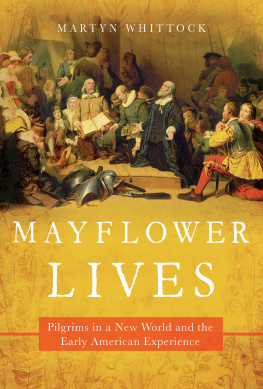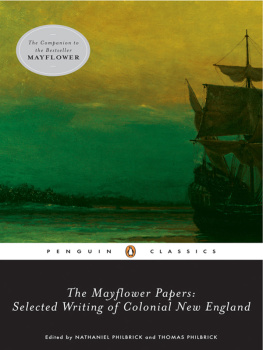CHAPTER II.
THE MAY-FLOWERS CONSORT THE SPEEDWELL
The SPEEDWELL was the first vessel procured by the Leyden Pilgrims for the emigration, and was bought by themselves; as she was the ship of their historic embarkation at Delfshaven, and that which carried the originators of the enterprise to Southampton, to join the MAY-FLOWER, whose consort she was to be; and as she became a determining factor in the latters belated departure for New England, she may justly claim mention here as indeed an inseparable part and parcel of the MAY-FLOWERS voyage.
The name of this vessel of associate historic renown with the MAY-FLOWER was even longer in finding record in the early literature of the Pilgrim hegira than that of the larger It first appeared, so far as discovered, in 1669nearly fifty years after her memorable service to the Pilgrims on the fifth page of Nathaniel Mortons New Englands Memorial.
Davis, in his Ancient Landmarks of Plymouth, makes a singular error for so competent a writer, when he says: The agents of the company in England had hired the SPEEDWELL, of sixty tons, and sent her to Delfthaven, to convey the colonists to Southampton. In this, however, he but follows Mather and the Modern Universal History, though both are notably unreliable; but he lacks their excuse, for they were without his access to Bradfords Historie. That the consort-pinnace was neither hired nor sent to Delfthaven duly appears.
Bradford states the fact,that a smale ship (of some 60 tune), was bought and fitted in Holand, which was intended to serve to help to transport them, so to stay in ye countrie and atend ye fishing and such other affairs as might be for ye good and benefite of ye colonie when they come ther. The statements of Bradford and others indicate that she was bought and refitted with moneys raised in Holland, but it is not easy to understand the transaction, in view of the understood terms of the business compact between the Adventurers and the Planters, as hereinafter outlined. The Merchant Adventurerswho were organized (but not incorporated) chiefly through the activity of Thomas Weston, a merchant of London, to finance the Pilgrim undertakingwere bound, as part of their engagement, to provide the necessary shipping, etc., for the voyage. The joint-stock or partnership, as it was called in the agreement of the Adventurers and Planters, was an equal partnership between but two parties, the Adventurers, as a body, being one of the co-partners; the Planter colonists, as a body, the other. It was a partnership to run for seven years, to whose capital stock the first-named partner (the Adventurers) was bound to contribute whatever moneys, or their equivalents,some subscriptions were paid in goods, were necessary to transport, equip, and maintain the colony and provide it the means of traffic, etc., for the term named. The second-named partner (the Planter body) was to furnish the men, women, and children, the colonists themselves, and their best endeavors, essential to the enterprise,and such further contributions of money or provisions, on an agreed basis, as might be practicable for them. At the expiration of the seven years, all properties of every kind were to be divided into two equal parts, of which the Adventurers were to take one and the Planters the other, in full satisfaction of their respective investments and claims. The Adventurers half would of course be divided among themselves, in such proportion as their individual contributions bore to the sum total invested. The Planters would divide their half among their number, according to their respective contributions of persons, money, or provisions, as per the agreed basis, which was: That every person joining the enterprise, whether man, woman, youth, maid, or servant, if sixteen years old, should count as a share; that a share should be reckoned at L10, and hence that L10 worth of money or provisions should also count as a share. Every man, therefore, would be entitled to one share for each person (if sixteen years of age) he contributed, and for each L10 of money or provisions he added thereto, another share. Two children between ten and sixteen would count as one and be allowed a share in the division, but children under ten were to have only fifty acres of wild land. The scheme was admirable for its equity, simplicity, and elasticity, and was equally so for either capitalist or colonist.
Goodwin notes, that, in an edition of Cushmans Discourse, Judge Davis of Boston advanced the idea that at first the Pilgrims put all their possessions into a common stock, and until 1623 had no individual property. In his edition of Mortons Memorial he honorably admits his error. The same mistake was made by Robertson and Chief Justice Marshall, and is occasionally repeated in this day. There was no community of goods, though there was labor in common, with public supplies of food and clothing. Neither is there warrant for the conclusion of Goodwin, that because the holdings of the Planters half interest in the undertaking were divided into L10 shares, those of the Adventurers were also. It is not impossible, but it does not necessarily follow, and certain known facts indicate the contrary.
Rev. Edward Everett Hale, in The Pilgrims Life in Common, says: Carver, Winslow, Bradford, Brewster, Standish, Fuller, and Allerton. were the persons of largest means in the Leyden group of the emigrants. It seems as if their quota of subscription to the common stock were paid in provisions for the voyage and the colony, and that by provisions is meant such articles of food as could be best bought in Holland. The good Doctor is clearly in error, in the above. Allerton was probably as well off as any of the Leyden contingent, while Francis Cooke and Degory Priest were probably better off than either Brewster or Standish, who apparently had little of this worlds goods. Neither is there any evidence that any considerable amount of provision was bought in Holland. Quite a large sum of money, which came, apparently, from the pockets of the Leyden Adventurers (Pickering, Greene, etc.), and some of the Pilgrims, was requisite to pay for the SPEEDWELL and her refitting, etc.; but how much came from either is conjectural at best. But aside from Hollands cheese, strong-waters (schnapps), some few things that Cushman names; and probably a few others, obtained in Holland, most of the provisioning, as repeatedly appears, was done at the English Southampton. In fact, after clothing and generally outfitting themselves, it is pretty certain that but few of the Leyden party had much left. There was evidently an understanding between the partners that there should be four principal agents charged with the preparations for, and carrying out of, the enterprise,Thomas Weston and Christopher Martin representing the Adventurers and the colonists who were recruited in England (Martin being made treasurer), while Carver and Cushman acted for the Leyden company. John Pierce seems to have been the especial representative of the Adventurers in the matter of the obtaining of the Patent from the (London) Virginia Company, and later from the Council for New England. Bradford says: For besides these two formerly mentioned, sent from Leyden, viz., Master Carver and Robert Cushman, there was one chosen in England to be joyned with them, to make the provisions for the Voyage. His name was Master Martin. He came from Billerike in Essexe; from which parts came sundry others to go with them; as also from London and other places, and therefore it was thought meet and convenient by them in Holand, that these strangers that were to goe with them, should appointe one thus to be joyned with them; not so much from any great need of their help as to avoid all susspition, or jealosie, of any partialitie. But neither Weston, Martin, Carver, nor Cushman seems to have been directly concerned in the purchase of the SPEEDWELL. The most probable conjecture concerning it is, that in furtherance of the purpose of the Leyden leaders, stated by Bradford, that there should be a small vessel for their service in fishing, traffic, etc., wherever they might plant the colony, they were permitted by the Adventurers to purchase the SPEEDWELL for that service, and as a consort, on general account.











